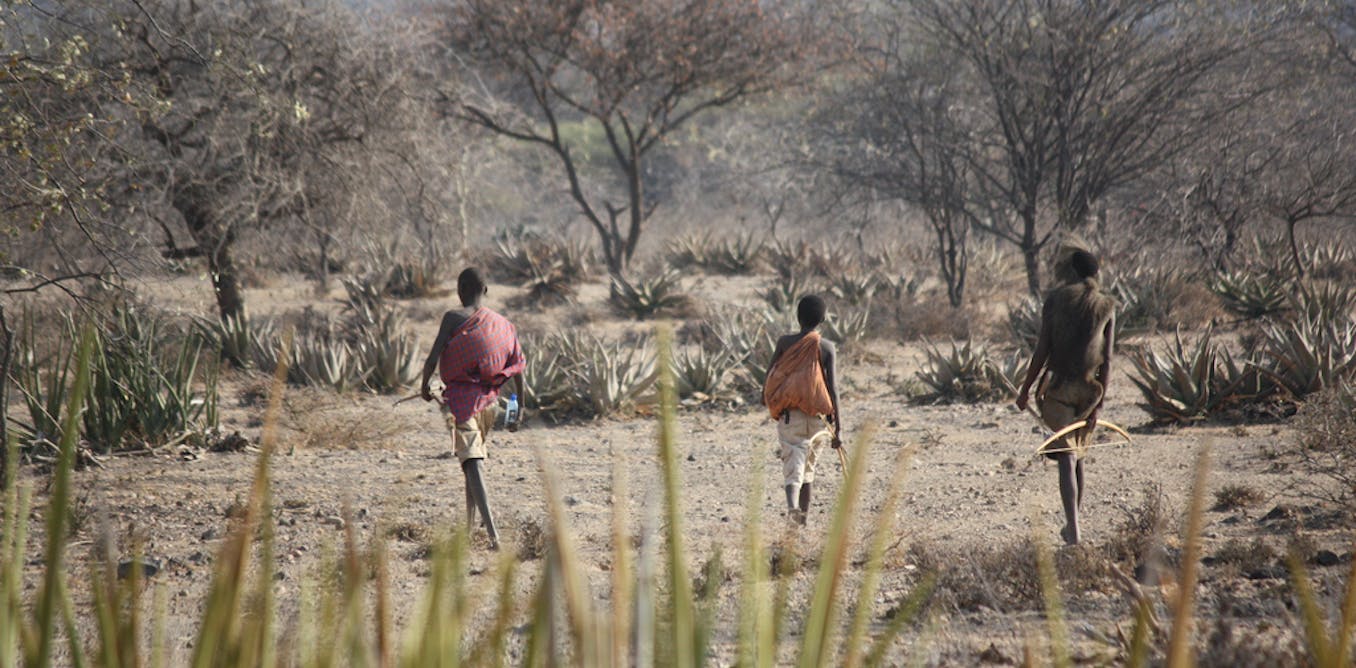
- Select a language for the TTS:
- UK English Female
- UK English Male
- US English Female
- US English Male
- Australian Female
- Australian Male
- Language selected: (auto detect) - EN
Play all audios:
Reconstructions of human evolution are prone to simple, overly-tidy scenarios. Our ancestors, for example, stood on two legs to look over tall grass, or began to speak because, well, they
finally had something to say. Like much of our understanding of early hominid behavior, the imagined diet of our ancestors has also been over-simplified. Take the trendy Paleo Diet which
draws inspiration from how people lived during the Paleolithic or Stone Age that ran from roughly 2.6 million to 10,000 years ago. It encourages practitioners to give up the fruits of modern
culinary progress – such as dairy, agricultural products and processed foods – and start living a pseudo-hunter-gatherer lifestyle, something like Lon Chaney Jr. in the film One Million BC.
Adherents recommend a very specific “ancestral” menu, replete with certain percentages of energy from carbohydrates, proteins and fats, and suggested levels of physical activity. These
prescriptions are drawn mainly from observations of modern humans who live at least a partial hunter-gatherer existence. But from a scientific standpoint, these kinds of simple
characterizations of our ancestors’ behavior generally don’t add up. Recently, fellow anthropologist C. Owen Lovejoy and I took a close look at this crucial question in human behavioral
evolution: the origins of hominid diet. We focused on the earliest phase of hominid evolution from roughly 6 to 1.6 million years ago, both before and after the first use of modified stone
tools. This time frame includes, in order of appearance, the hominids _Ardipithecus_ and _Australopithecus_, and the earliest members of our own genus, the comparatively brainy _Homo_. None
of these were modern humans, which appeared much later, but rather our distant forerunners. We examined the fossil, chemical and archaeological evidence, and also closely considered the
foraging behavior of living animals. Why is this crucial? Observing animals in nature for even an hour will provide a ready answer: almost all of what an organism does on a daily basis is
simply related to staying alive; that includes activities such as feeding, avoiding predators and setting itself up to reproduce. That’s the evolutionary way. What did our ancestors actually
eat? In some cases, researchers can enlist modern technology to examine the question. Researchers study the chemical makeup of fossil dental enamel to figure out relative amounts of foods
the hominid ate derived from woody plants (or the animals that ate them) versus open country plants. Other scientists look in ancient tooth tartar for bits of silica from plants that can be
identified to type – for example, fruit from a particular plant family. Others examine the small butchering marks made on animal bones by stone tools. Researchers have found, for example,
that hominids even 2.6 million years ago were eating the meat and bone marrow of antelopes; whether they were hunted or scavenged is hotly debated. Such techniques are informative, but
ultimately give only a hazy picture of diet. They provide good evidence that plants’ underground storage organs (such as tubers), sedges, fruits, invertebrate and vertebrate animals, leaves
and bark were all on the menu for at least some early hominids. But they don’t give us information about the relative importance of various foods. And since these foods are all eaten at
least occasionally by living monkeys and apes, these techniques don’t explain what sets hominids apart from other primates. So how should we proceed? As my colleague Lovejoy says, to
reconstruct hominid evolution, you need to take the rules that apply to beavers and use them to make a human. In other words, you must look at the “rules” for foraging. We aren’t the first
researchers to have dabbled in this. As long ago as 1953, anthropologists George Bartholomew and Joseph Birdsell attempted to characterize the ecology of early hominids by applying general
biological principles. Happily, ecologists have long been compiling these rules in an area of research dubbed optimal foraging theory (OFT). OFT uses simple mathematical models to predict
how certain animals would forage in a given circumstance. For instance, given a set of potential foods of estimated energetic value, abundance and handling time (how long it takes to acquire
and consume), one classic OFT model calculates which resources should be eaten and which ones should be passed over. One prediction — sort of a “golden rule” of foraging — is that when
profitable foods (those high in energy and low in handling time) are abundant, an animal should specialize on them, but when they are scarce, an animal should broaden its diet. Data from
living organisms as disparate as insects and modern humans generally fall in line with such predictions. In the Nepal Himalaya, for example, high-altitude gray langur monkeys eschew leathery
mature evergreen leaves and certain types of roots and bark — all calorie-deficient and high in fibers and handling time — during most of the year. But in the barren winter, when better
foodstuffs are rare or unavailable, they’ll greedily devour them. In another more controlled study, when differing quantities of almonds in or out of the shell are buried in view of
chimpanzees, they later recover larger quantities (more energy), those physically closer (less pursuit time), and those without shells (less processing time) before smaller, more distant, or
“with-shell” nuts. This suggests that at least some animals can remember optimal foraging variables and utilize them even in cases where foods are distant and outside the range of immediate
perception. Both of these studies support key predictions from OFT. If one could estimate the variables important to foraging, one could potentially predict the diet of particular hominids
that lived in the distant past. It’s a daunting proposition, but this human evolution business was never meant to be easy. The OFT approach forces researchers to learn how and why animals
exploit particular resources, which leads to more thoughtful considerations of early hominid ecology. A smattering of scientists have utilized OFT with success, most notably in
archaeological treatments of comparatively recent hominids, such as Neandertals and anatomically modern humans. But a few brave souls have delved into more remote human dietary history. One
team, for example, utilized OFT, modern analogue habitats, and evidence from the fossil record, to estimate the predicted optimal diet of _Australopithecus boisei_. That’s the famed
“Nutcracker Man” that lived in East Africa close to 2 million years ago. The research suggests a wide range of potential foods, greatly varying movement patterns – based on characteristics
such as habitat or use of digging sticks — and the seasonal importance of certain resources, such as roots and tubers, for meeting estimated caloric requirements. Researchers Tom Hatley and
John Kappelman noted in 1980 that hominids have bunodont – low, with rounded cusps – back teeth that show much in common with bears and pigs. If you’ve watched these animals forage, you know
they’ll eat just about anything: tubers, fruits, leafy materials and twigs, invertebrates, honey and vertebrate animals, whether scavenged or hunted. The percentage contribution of each
food type to the diet will depend (you guessed it) on the energetic value of specific foods in specific habitats, at specific times of year. Evidence from the entirety of human evolution
suggests that our ancestors, and even we as modern humans, are just as omnivorous. And the idea that our more ancient ancestors were great hunters is likely off the mark, as bipedality — at
least before the advance of sophisticated cognition and technology — is a mighty poor way to chase game. Even more so than bears and pigs, our mobility is limited. The anthropologist Bruce
Latimer has pointed out that the fastest human being on the planet can’t catch up to your average rabbit. Another reason to be opportunistic about food. Simple characterizations of hominid
ecology are divorced from the actual, and wonderful, complexity of our shared history. The recent addition of pastoral and agricultural products to many modern human diets — for which we
have rapidly evolved physiological adaptations — is but one extension of an ancient imperative. Hominids didn’t spread first across Africa, and then the entire globe, by utilizing just one
foraging strategy or sticking to a precise mix of carbohydrates, proteins and fats. We did it by being ever so flexible, both socially and ecologically, and always searching for the greener
grass (metaphorically), or riper fruit (literally).






:max_bytes(150000):strip_icc():focal(745x543:747x545)/green-puppy-110624-41e77ca4072d438b874dd32eb7f822c9.jpg)
